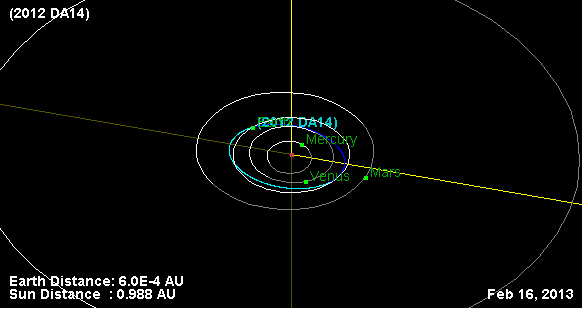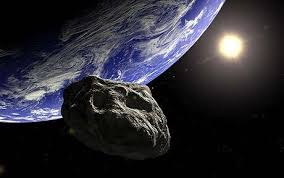Could Earth be impacted by large asteroid February 15-16, 2013?

 March 4, 2012 – SPACE – Scientists are predicting that the asteroid 2012 DA14 has a good chance of colliding with earth in eleven months. Watch the skies in February 2013! According to RT, NASA has confirmed that the 60 meter (or 197 feet) asteroid, which was spotted by Spanish stargazers in February this year, has a good chance of colliding with earth. The scientists suggest confronting this asteroid with either big guns or, more strangely, with paint. The problem with either option is that there is no time to build a spaceship for the operation. A spaceship could either shoot the asteroid down or simply crash into it – this would either break it into pieces or throw it off course. NASA expert David Dunham suggested: “We could paint it.” The paint would change the asteroid’s ability to reflect sunlight, alter its spin and change its temperature. However, even taking the asteroid off course could be dangerous when it returns in 2056, according to Aleksandr Devaytkin the head of the observatory in Russia’s Pulkovo, as told to Izvestia in Russia recently. The asteroid’s closest approach to earth is scheduled for 15 February 2013, when they predict that the distance between it and earth will be under 27,000 km (16,700 miles). With the asteroid zooming that low, it will be too late to do anything with it besides trying to predict its final destination and the consequences of impact. However, NASA’s David Dunham did say: “The asteroid may split into pieces entering the atmosphere. In this case, most parts of it will never reach the planet’s surface.” But theories are that if the entire asteroid did crash into the planet, the impact will be as hard as in the Tunguska blast, which in 1908 knocked down trees over a total area of 2,150 sq km (830 sq miles) in Siberia. So keep your head down and watch the skies. –Digital Journal
March 4, 2012 – SPACE – Scientists are predicting that the asteroid 2012 DA14 has a good chance of colliding with earth in eleven months. Watch the skies in February 2013! According to RT, NASA has confirmed that the 60 meter (or 197 feet) asteroid, which was spotted by Spanish stargazers in February this year, has a good chance of colliding with earth. The scientists suggest confronting this asteroid with either big guns or, more strangely, with paint. The problem with either option is that there is no time to build a spaceship for the operation. A spaceship could either shoot the asteroid down or simply crash into it – this would either break it into pieces or throw it off course. NASA expert David Dunham suggested: “We could paint it.” The paint would change the asteroid’s ability to reflect sunlight, alter its spin and change its temperature. However, even taking the asteroid off course could be dangerous when it returns in 2056, according to Aleksandr Devaytkin the head of the observatory in Russia’s Pulkovo, as told to Izvestia in Russia recently. The asteroid’s closest approach to earth is scheduled for 15 February 2013, when they predict that the distance between it and earth will be under 27,000 km (16,700 miles). With the asteroid zooming that low, it will be too late to do anything with it besides trying to predict its final destination and the consequences of impact. However, NASA’s David Dunham did say: “The asteroid may split into pieces entering the atmosphere. In this case, most parts of it will never reach the planet’s surface.” But theories are that if the entire asteroid did crash into the planet, the impact will be as hard as in the Tunguska blast, which in 1908 knocked down trees over a total area of 2,150 sq km (830 sq miles) in Siberia. So keep your head down and watch the skies. –Digital Journal

As you can see, the Earth distance of object 2012 DA14 on the JPL chart approaches 16,700 miles on February 16, 2013, where the question of gravity accretion could be an issue depending on the trajectory path of the asteroid. It could also be a miss. The A.M. or Apparent Magnitude scale puts the object’s brightness at 24.4 H, which would make it a little brighter than Pluto’s moon, Nix, which means it would not be highly visible to the naked eye until it entered Earth’s atmosphere. -The Extinction Protocol
 Earth’s gravity: Earth could capture an asteroid, but only under certain conditions. The asteroid would have to be a certain size, traveling at just the right speed, and grazing by Earth at just the right angle. For example, a bus-sized asteroid grazing Earth’s atmosphere might be captured by our planet’s gravity. Afterward, moon’s gravity might pull it into a stable orbit above Earth – to give Earth a second moon. Planetary scientists believe that asteroid capture was common billions of years ago. The planets are thought to have formed by a process of “accretion” – where small chunks of debris came together to form larger chunks. So there were lots more chunks – what we now call “asteroids” – moving through the solar system back then. –Earth-Sky
Earth’s gravity: Earth could capture an asteroid, but only under certain conditions. The asteroid would have to be a certain size, traveling at just the right speed, and grazing by Earth at just the right angle. For example, a bus-sized asteroid grazing Earth’s atmosphere might be captured by our planet’s gravity. Afterward, moon’s gravity might pull it into a stable orbit above Earth – to give Earth a second moon. Planetary scientists believe that asteroid capture was common billions of years ago. The planets are thought to have formed by a process of “accretion” – where small chunks of debris came together to form larger chunks. So there were lots more chunks – what we now call “asteroids” – moving through the solar system back then. –Earth-Sky

 March 4, 2012 – SPACE – Scientists are predicting that the asteroid 2012 DA14 has a good chance of colliding with earth in eleven months. Watch the skies in February 2013! According to RT, NASA has confirmed that the 60 meter (or 197 feet) asteroid, which was spotted by Spanish stargazers in February this year, has a good chance of colliding with earth. The scientists suggest confronting this asteroid with either big guns or, more strangely, with paint. The problem with either option is that there is no time to build a spaceship for the operation. A spaceship could either shoot the asteroid down or simply crash into it – this would either break it into pieces or throw it off course. NASA expert David Dunham suggested: “We could paint it.” The paint would change the asteroid’s ability to reflect sunlight, alter its spin and change its temperature. However, even taking the asteroid off course could be dangerous when it returns in 2056, according to Aleksandr Devaytkin the head of the observatory in Russia’s Pulkovo, as told to Izvestia in Russia recently. The asteroid’s closest approach to earth is scheduled for 15 February 2013, when they predict that the distance between it and earth will be under 27,000 km (16,700 miles). With the asteroid zooming that low, it will be too late to do anything with it besides trying to predict its final destination and the consequences of impact. However, NASA’s David Dunham did say: “The asteroid may split into pieces entering the atmosphere. In this case, most parts of it will never reach the planet’s surface.” But theories are that if the entire asteroid did crash into the planet, the impact will be as hard as in the Tunguska blast, which in 1908 knocked down trees over a total area of 2,150 sq km (830 sq miles) in Siberia. So keep your head down and watch the skies. –Digital Journal
March 4, 2012 – SPACE – Scientists are predicting that the asteroid 2012 DA14 has a good chance of colliding with earth in eleven months. Watch the skies in February 2013! According to RT, NASA has confirmed that the 60 meter (or 197 feet) asteroid, which was spotted by Spanish stargazers in February this year, has a good chance of colliding with earth. The scientists suggest confronting this asteroid with either big guns or, more strangely, with paint. The problem with either option is that there is no time to build a spaceship for the operation. A spaceship could either shoot the asteroid down or simply crash into it – this would either break it into pieces or throw it off course. NASA expert David Dunham suggested: “We could paint it.” The paint would change the asteroid’s ability to reflect sunlight, alter its spin and change its temperature. However, even taking the asteroid off course could be dangerous when it returns in 2056, according to Aleksandr Devaytkin the head of the observatory in Russia’s Pulkovo, as told to Izvestia in Russia recently. The asteroid’s closest approach to earth is scheduled for 15 February 2013, when they predict that the distance between it and earth will be under 27,000 km (16,700 miles). With the asteroid zooming that low, it will be too late to do anything with it besides trying to predict its final destination and the consequences of impact. However, NASA’s David Dunham did say: “The asteroid may split into pieces entering the atmosphere. In this case, most parts of it will never reach the planet’s surface.” But theories are that if the entire asteroid did crash into the planet, the impact will be as hard as in the Tunguska blast, which in 1908 knocked down trees over a total area of 2,150 sq km (830 sq miles) in Siberia. So keep your head down and watch the skies. –Digital Journal
Δεν υπάρχουν σχόλια:
Δημοσίευση σχολίου